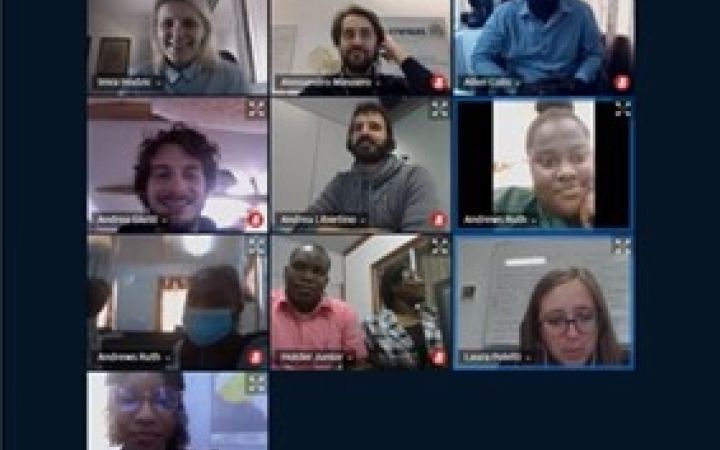8 April 2021, Georgetown, Guyana & Geneva, Switzerland – Between 18 January and 02 February 2021 UNOSAT and CIMA in partnership with UNDP, Guyana delivered a 12-day technical course entitled “Operational Flood Forecasting System”. The course focused on the operational use of the hydrologic/hydraulic models and flood forecasting chain implemented at Hydrometeorological Service, Ministry of Agriculture, Guyana. Due to travel restrictions resulting from the COVID-19 pandemic, the training was delivered remotely in a moderated e-learning format.
This course falls under the “Strengthening Women’s Disaster Management Capacities in Guyana and Dominica” project funded by the Government of Japan and implemented nation-wide to reduce vulnerabilities to hydro-meteorological hazards such as floods and droughts. It follows the “Geospatial Information Technology for Flood Risk Management (GIT4FRM)” course that took place between 16 November and 11 December 2020, as well the implementation of a flood forecasting platform for Guyana (see links below for further information).
Participants expressed satisfaction with the quality of the course, as exemplified by Mr. Junior Holder, Engineer, Hydrometeorological Service of Guyana:
It’s my view that the Operational Flood Forecasting Training was pertinent and comprehensible. The training brought together staff working on maps in QGIS (Quantum Geographic Information System) and writing scripts to get the operational model to run. Moreover, the training and the operationalization of the Forecasting tool will place us in a position to better fulfill our mandate in forecasting.
Disasters such as floods and droughts represent a recurring threat for the development of Guyana’s agricultural sector, negatively impacting local communities and the fight to reduce poverty and economic inequalities.
This course provided 11 Hydromet technical officers with the knowledge and skills to use, interpret and maintain the operational flood forecasting chain (FloodPROOFS) and related models (Continuum, Hydra-2D). These tools are implemented in the Hydromet office and use the Caribbean Dewetra Platfrom for the results visualisation.
To provide participants with flexibility in terms of pacing, self-study and attendance, the online course was delivered over 3 weeks. An additional 2 weeks were allotted for participants to complete their assignments. Following an initial assessment, five (5) modules were completed during the training period and capped off with the final assessment. The course was conducted using an e-learning model, combining webinar sessions with asynchronous learning through a dedicated platform.
Concepts and terminology related to operational hydrology, early warning and modelling procedures were shared during the training. Through hands-on sessions, participants were taught to -use the Dewetra platfrom and interpret results for extreme flood events. Participants also enhanced their capacities using hydrological and hydraulic models. An introduction to GIS software for hydrological analyses was also given.
Ms. Shyon Niles, Hydrological Technician at the Hydrometeorological Service of Guyana, made the following statement:
I must say that the training was well organized. The overall objective of the training was met. I can say that I personally have a better understanding of how to use geospatial data and how to prepare and analyse time series data for hydrological modelling. This particular aspect of the training was very significant for me given the fact that my current job description deals with the use of GIS software to create maps for my section. It will most definitely be an asset to myself personally and also to the effectiveness of the work. However, I did have some minor challenges as it relates to the Continuum but they were eventually resolved. The Training was well done and I would definitely recommend it to my colleagues.
The course was well received by participants who expressed satisfaction with the performance of the instructors and eagerness for additional learning opportunities. Mr. Colis Allen, Specialist Hydrologist at the Hydrometeorological Service of Guyana provided the following feedback:
Both the system and the training were much needed within my agency. The knowledge acquired throughout this project will go a long way in enhancing the country's flood early warning efforts. On behalf of the water resources department of the Hydrometeorological Service of Guyana, I would like to say thank you to the entire project team.
The course evaluation report, based on a survey designed to measure the relevance of the content for the professional development of participants, garnered high marks in all categories. Respondents unanimously agreed that the course was useful and relevant for their job, that the methodology was appropriate and that they would recommend the course to colleagues. Two-thirds found that the information presented during the course was new to them, 90% had never worked using a flood forecasting operational chain and three-quarters had no or partial aptitude to execute the learning objectives before the training. After the training, 4 out 5 participants expressed confidence that they had achieved the learning objectives. Finally, out of the 9 participants who successfully completed the course, we are pleased to report that 65% were women.
UNOSAT and CIMA’s contribution to the project is scheduled to reach its conclusion later this year. For the next step, a “Raising awareness about Flood Early Warning Communication” workshop is planned via teleconference.
For more information, please contact UNOSAT at unosat@unitar.org or UNDP Guyana at registry.gy@undp.org.



